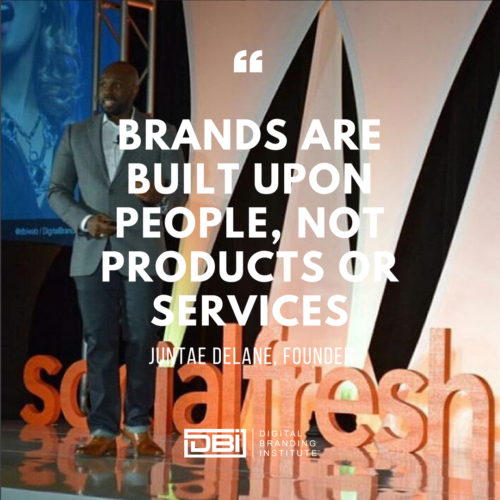We all understand the importance of having healthy relationships in our lives.
But, we may often forget how healthy relationships impact our businesses.
Of all the success metrics, if we measure brands the way we measure healthy relationships, we can easily outperform the competition.
That’s why you should understand the reasons why consumers view brands as relationships.
Continue reading to find out how to get your target audience to fall in love with you.
Metrics are an integral part of a brand’s strategy. They help businesses understand how their brand is performing within the framework of customer values and expectations.
Unfortunately, however, many brand marketers consider share of voice and brand loyalty as the top performance metrics.
What about brand relationships?
Organizations should consider their branding efforts as a relationship with consumers.
Similar to human relationships, brands must take elements of traditional relationship building and apply them to its overarching brand strategy.
For instance, think about the relationships in your life…
- Do you look forward to seeing that person?
- Do you care about them?
- Do they share your values?
- Do you speak well of them to others?
To truly understand your brand perception, you should ask yourself these questions:
- Does your brand presence compare to the relationships you have built over the years?
- If not, what can you do to mimic the positive dynamics of such relationships?
- If so, can you identify what actions it took to get you in your consumer’s good graces?

Given the abundance of competitive information and the content available online, today’s consumers are more informed than ever.
This has resulted in a drastic shift in consumer power and has altered the selling process by placing a greater emphasis on the customer experience.
Here are 4 reasons why consumers view brands as relationships
1. They Prefer Organic Discovery Over The Traditional Purchase Process
Today’s consumers come to a brand through many online sources such as social media, search engines, reviews, peer recommendations and more.
Marketing is no longer leading consumers to brands; it’s the relationships we have with one another that are leading them to brands.
The relationship is formed through your digital branding efforts.
You can’t be in all places online, but a great digital brand will leave breadcrumbs around the Internet that will lead your consumer directly to you.
SEE ALSO: What Is Digital Branding

Recently, content marketing has played a major role in building consumer relationships by placing brands in the middle of a consumer’s purchasing journey.
Great content will provide answers to consumer’s questions or help them with a challenge as they search for a solution online. Your content can draw a consumer’s attention during their search.
Your content can draw a consumer’s attention during their search. By providing relevant content related to their purchase, you are instantly building a positive relationship.
Here’s another reason consumers view brands as relationships…
SEE ALSO: How to Use Content Marketing to Build Your Digital Brand
2. They Have Moved Beyond Traditional Marketing to User Generated Demand
Today, user-generated content is more trustworthy than traditional media. Simply put, consumers believe high-end productions are fabricated and only convey the positive attributes of the product or service advertised. Overall, they would rather trust their peers than brands.
 Also, there was a significant market shift after the financial meltdown. Consumers lost trust in major corporations when financial and housing institutions’ unethical business practices were exposed.
Also, there was a significant market shift after the financial meltdown. Consumers lost trust in major corporations when financial and housing institutions’ unethical business practices were exposed.
There was a negative connotation to the word ‘corporation’ and consumers felt bamboozled.
Do you recall the Occupy Wall Street movement?

Ever since that movement, companies across all business sectors had to revamp their communication strategies. They were forced to become more transparent.
And that’s where the shift began.
Consumers wanted their voices heard and, as a result, it shaped our current market situation. Companies transferred the power to the people and had them play a key role in the companies product offerings.
After this trend caught fire, many companies began leveraging the consumer’s voice when developing new products.
Perhaps the light-hearted Lay’s Do Us A Flavor campaign is the best example.
Now on to the third reason consumers view brands as relationships…
3. They Have Moved Beyond Traditional Service Transactions to Personal Interactions
Let’s face it. Customer service transactions have changed forever. Now consumers expect to have their problems resolved without ever calling or email customer service.
They are taking their grievances to social media as it naturally amplifies their voice. Mainly, social media complaints can become viral and negatively impact other consumers’ relationship with your brand as well.
SEE ALSO: How to Use Social Media to Develop Your Digital Brand Voice
As a result, companies became proactive in solving consumer problems before a formal complaint is conducted.
Particularly, this is done through active social listening and remedied with very personal interaction.
Moreover, Southwest Airlines is known for personal interactions with passengers. The airline works to ensure they are “humanizing” the travel experience by showcasing the personalities of crewmembers, flight attendants, and pilots.
Southwest also established a Social Care Team with full-time employees that provide extraordinary customer service.
This team utilizes a social media command center to listen actively and respond to customers.
Going above and beyond is not limited to social media. For instance, a Southwest flight attendant turned a traditional service transaction into a personal interaction. Take a look. This video has over 20 million views!
Here’s the last reason consumers view brands as relationships…
4. They Have Moved Beyond Product Transactions to Human Interactions
If you’ve been in the sales industry, you are familiar with the phrase, sell the sizzle, not the steak. (Unless it’s Gibson’s Steakhouse in Chicago. No need for any sizzle on that steak. Best steak I ever had)
OK, let’s get back on track.
Nike is known for selling the sizzle. It communicates how its products can help customers reach their athletic and fitness goals. For example, it created communities around the Nike+ product that serve as a platform for runners with a shared interest.
Understand how Nike has created a community around their product and see if you can create something similar for your product or service.
Consumers will naturally feel more comfortable using your product when they know there’s a community of fellow customers along with them.
Overall, if you remember one point from this post, you should know that implementing a human interaction will foster stronger relationships and increase brand loyalty.
Final Thoughts
Your consumers are prioritizing organic discovery, user-generated demand, personal and human interactions. This means you should prioritize engagement when developing your marketing strategies.
Engagement is key.
The type of engagement that goes beyond the traditional marketing tactics and complements your consumers’ values and expectations. There is a reason consumers view brands as relationships.
Brands are starting to engage with consumers in ways in which they wish to be engaged.
The days of one-way communication are done. The relationship begins when both the brand and consumer are on equal footing. The only way this is accomplished is if a brand becomes more human and more personal.
You know, the stuff that built the great relationships people have today. This process is no different.
I have discussed many positives for building a relationship with consumers, but can you name any caveats or backlash from humanizing your brand?











